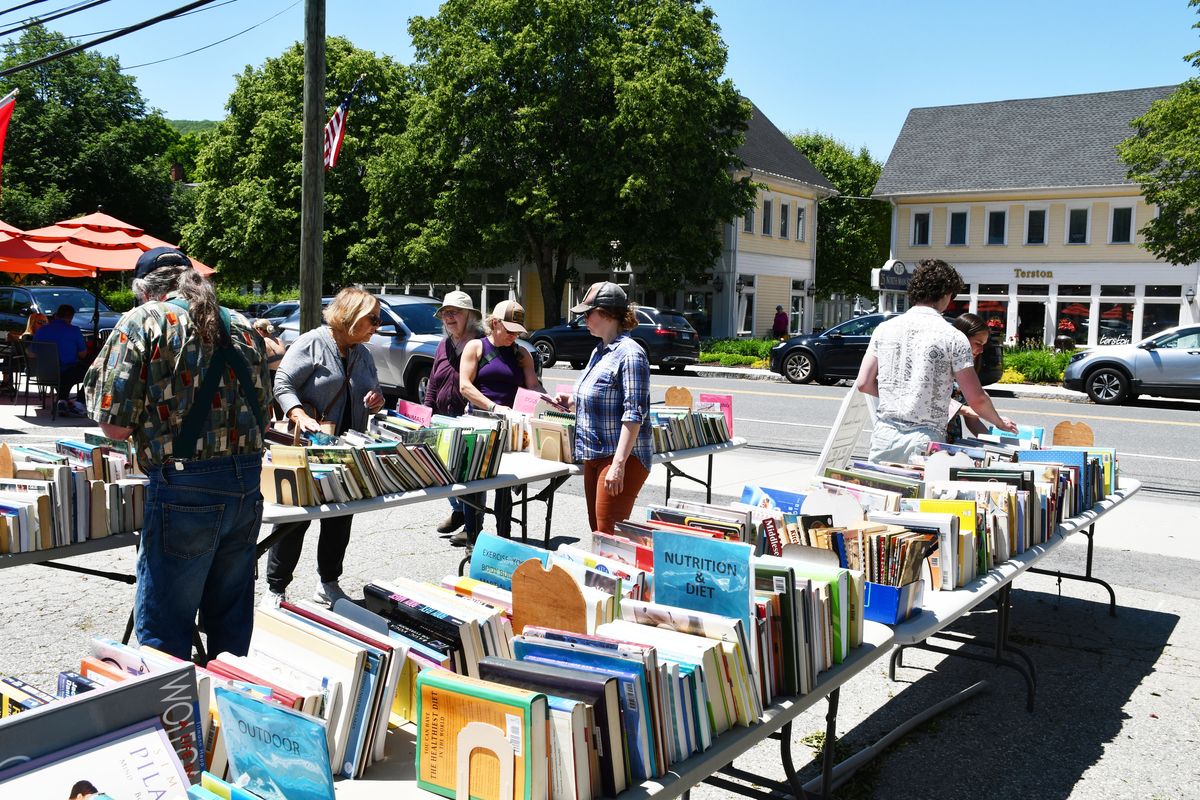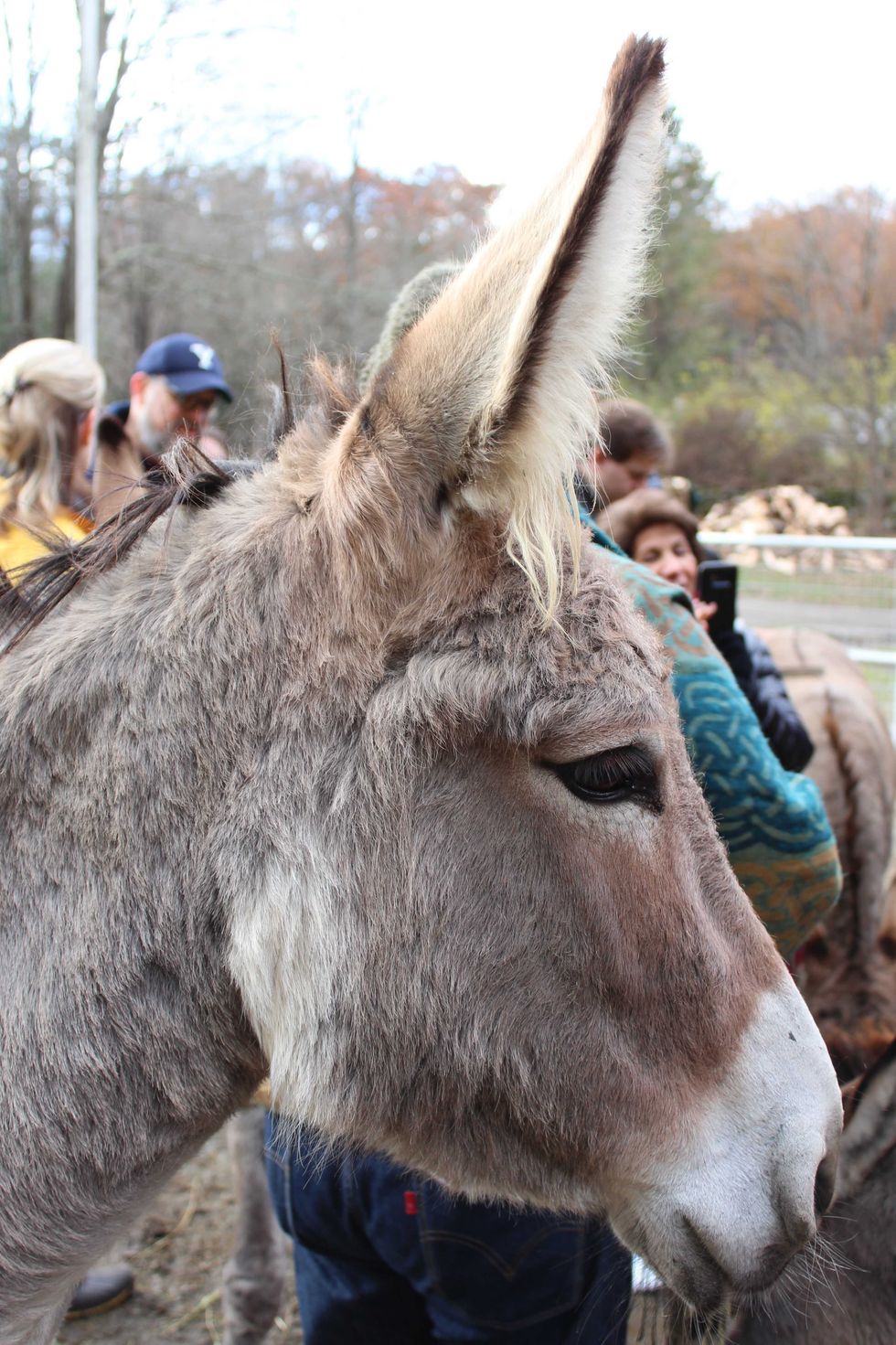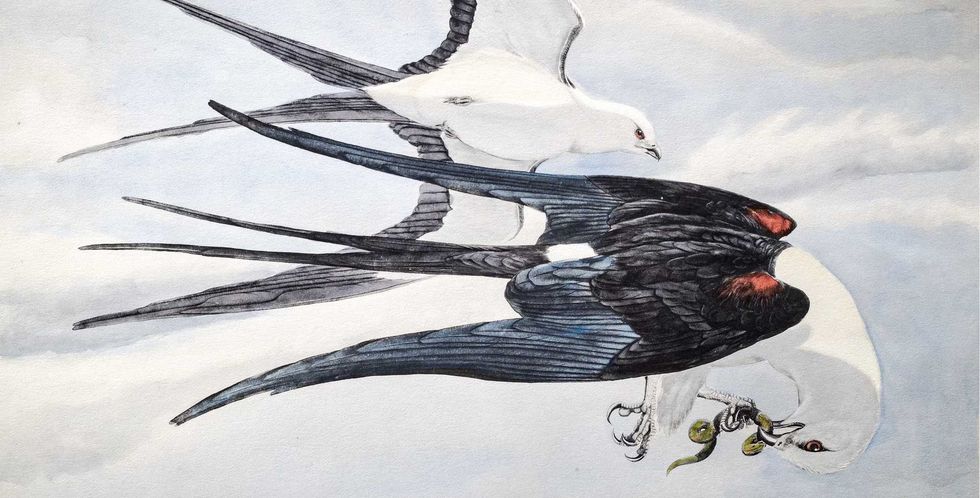Volunteers are heart and soul of library’s massive book sale

The plaza in front of the Kent Memorial Library is thronged throughout the summer — weather permitting — as shoppers look for bargains on books.
Kathryn Boughton

The plaza in front of the Kent Memorial Library is thronged throughout the summer — weather permitting — as shoppers look for bargains on books.
KENT — There is an African proverb that says it takes a village to raise a child. It’s not a child, but the proverb could as easily be applied to the Kent Memorial Library, a cultural hub for the community that relies on the unstinting assistance of a dedicated cadre of volunteers.
“We’re number one in Connecticut for the number of volunteer hours given,” said library Director Sarah Marshall, noting that just in May, while setting up for this year’s summer-long book sale, volunteers logged 389 hours. On average, during months when the annual sale is underway, volunteers give 350 hours a month.
And that’s just for the book sale. Other volunteers are racking up hours in other ways. “We were just under 600 hours for volunteer hours in May, if you include all that the board members do.”
The role of volunteers was a sentiment endorsed by Eric and Elise Cieplik, long-time workers. “Volunteers are how we put on the book sale each weekend from Memorial Day until late October,” they said. “Volunteers sort, clean and make sure the books are ready for sale. It’s the volunteers and it’s their passion for the library and the place it holds in the community.”
“The book sale is successful because of four factors: donors, volunteers, customers and, our silent partner, the weatherman, who, alas, does not take bribes,” added long-time book sale devotee Jon LaFleur whimsically.
Even with a history of dedicated volunteers that have kept the sale afloat for five decades, their numbers must continually be refreshed with new recruits. LaFleur said there are specific areas that need help immediately. “Substitute cashiers on the Sunday 10-1:30 shift are needed immediately for June 16 and 23,” he said.
And even with 20,000 to 30,000 books passing through the sale each year, he said some areas are not as well-stocked as others. “We need more books in some categories,” he added. “Business/investments and health advice books must be current, and we need books about popular musicians. The three B’s [Bach, Beethoven and Brahms] do not sell, but Bon Jovi and the Beatles do.”
This year, volunteer Bethany Keck put out repeated calls for more children’s books.
The book sale has been around for about a half century, according to Marshall, and is one of the few remaining of its magnitude. “Most local libraries have shut down their sales because they take incredible time and space. Most libraries used to have them and now have closed them, or they have shrunken over time,” she said.
Books are received all year round and are sorted and assessed by a crew of workers. “We get books from all over, at least from a 50 to 100-mile radius” she said. “We even have people who mail them to us. We get 10 to 15 banker’s boxes full of books a week — at least. It’s an insane amount of books. We rely a lot on an endless pipeline.”
The volunteers sort and select the books, assigning them to different categories. “It takes a lot of time, and each team has its own section that they sort. They know what they sell,” she said. Some of the books that come in have additional value, and these are sorted out and sold online or in the library. Very rarely, something of real value is missed by the sorters and is sold for a song.
“We had a first edition of Catcher in the Rye that was marked $1,” she remembered. “We sold it for $1, but, because we were not paying for it, we were not losing money. What we lost is opportunity.”
“People are coming to find deals, not rare books,” she said. “At the very beginning of the season, it’s the dealers who show up and they check to see what they can get. On opening day, we had 20 dealers lined up for an hour before we opened. We keep beautiful leather-bound sets or things of local interest like books by Kissinger or Eric Sloane in the library, but that is maybe 25 books a year.”
This well-oiled machine will hit a snag next year when the library is expanded and renovated. There will be no physical book sale next year with the familiar blue-tarped tables in the plaza. “We hope to extend our online sales and make some money that way,” Marshall said of the hiatus, but the lack of the sale with be noticeable in the summer hustle and bustle of Kent’s center. “It’s a real tourist attraction,” said Marshall.
Adjustments will have to be made in procedure even after the addition is completed. Since 2007, the library has had the luxury of storing books in the old firehouse adjacent to the library. The renovation will connect the two buildings and the firehouse will become the section where the book stacks are placed. Upstairs will be a large assembly room.
“The book sale is important to our bottom line, but it is not our mission,” said Marshall. “The firehouse will have a fairly small intake area where we can triage the donations, but we need to figure out where we will store them. But we didn’t have the firehouse before ’07 and the book sale has been around for 50 years—it’s not an insurmountable problem.”
The book sale is the largest fundraiser conducted by the library. “It’s a big, complicated effort and we certainly couldn’t do it without the volunteers, but people love it. People love to sit outside and chat. There are lots of happy faces out there,” said Marshall.
Principal Leanne Maguire added a bit of seasonal excitement to the morning drop-off Thursday, Dec. 18, at Cornwall Consolidated School. Dressed as an elf, Maguire was lifted above the school’s front entrance to greet arriving students. The tree bucket was provided by Gervais & Sons Inc.
Keri LaBella of Worcester, Mass., visited the donkeys at Trinity Retreat Center in early December during a women’s retreat.
CORNWALL — On a quiet patch of farmland where West Cornwall’s forested hills roll down toward the Housatonic River, six donkeys lift their heads at the sound of approaching footsteps. Their long ears twitch. Their breaths plume in the frigid air.
The soft brays that greet visitors to Trinity Retreat Center have become part of the landscape here — a warm, familiar sound that carries across the snow-covered fields as December settles in.
The 55-acre spiritual retreat and conference center offers space for rest, reflection and prayer.
For Trinity’s staff, volunteers and the thousands who pass through the retreat center each year, these rescued donkeys have become far more than barn residents guarding the center’s flock of 32 chickens from predators.
They are companions, teachers and symbols of resilience. And at Christmastime, they serve as a living reminder of the season’s most enduring themes: humility, hope and the beauty of second chances.
“The donkeys have an incredible intuition,” said Jason Coppola, director of the retreat center. “They can feel a person’s energy and when they sense people are in need, they tend to gravitate towards them.”
The donkeys, which today live peacefully in West Cornwall, did not begin their lives in such calm surroundings. Their histories, while varied, share a somber thread: all were rescued from kill pens, the last stop for animals before being shipped for slaughter overseas. Donkeys, especially, are at risk because their hides are used to produce a gelatin-based traditional medicine.
Eight years ago, Trinity’s leadership learned that a group of donkeys had been saved from these conditions and were in immediate need of placement. What began as a simple sheltering effort quickly grew into something deeper.
“They arrived frightened, confused and unsure of people,” Joseph Rose, the center’s former co-director who rescued the donkeys, said in an interview conducted shortly after their arrival.
“They had good reason. But one of the most beautiful things has been watching them learn to trust again.”
Some donkeys were severely underweight, including two that were later found to be pregnant. Others arrived with untreated injuries or chronic hoof problems. With patience, veterinary care and daily interaction from staff and volunteers, the animals gradually emerged from their fear.
As the donkeys healed, their presence began to shape the experience of the people who come to the retreat center seeking rest and reflection.
“A lot of our retreatants are generally here to help process through things and try new things,” said Laura Alexander, the retreat center’s facilities and farm manager who has tended to the donkeys since shortly after their arrival.
Today, each donkey — Marge, Lisa, Maggie, Fern, Francine and Buster — has a distinct personality. The gentle one that prefers long quiet walks, the inquisitive one that nudges visitors for scratches, the matriarch that keeps watch over the herd, the youngster that still bounds with playful energy.
On a recent weekday in early November, Keri LaBella of Worcester, Massachusetts, and about two dozen others on a women’s retreat visited the donkeys during early afternoon feeding time as part of the farm tour. As daylight dwindled, she made a solo return,

While stroking the ear of a donkey that had leaned in toward her, LaBella noted that in an era when holiday celebrations can feel rushed and commercialized, this quiet ritual, still, earthy and unadorned, offers something rare: presence. “It’s difficult not to feel something soften inside you.”
She said she feels connected to the donkeys “because they are a lot like me. You really can’t make them do something they don’t think is safe. They’re smart, curious and they love a challenge. And I just love the story of their rescue.”
Visitors of all ages, whether on retreat or neighbors in Cornwall, are invited to join daily donkey care sessions like brushing, walking, offering hay and fresh water and learning the animals’ rescue stories.
“One guest spent all day with the donkeys,” helping with feeding and brushing the animals’ coats, recalled Coppola, who lives on the property a stone’s throw from the barn.
Children visiting from the city, he explained, are so enamored by the experience that many of them return as volunteers.
“It’s wonderful to see the long-lasting impression they have interacting with the donkeys,” said Coppola of the visitors.
For children, meeting the donkeys is often a highlight of their stay.
For adults, the effect can be surprisingly emotional. Some visitors have shared that time with the donkeys helped them through grief, burnout or difficult transitions.
At Trinity, these moments are not separate from the spiritual experience — they are part of it.
‘An amazing 2025’
As of early December, there was no room at the center. Coppola said all 25 guest rooms were booked into the new year.
“It’s been an amazing 2025 and we expect 2026 to be even better. People come here and they leave a different person. It’s incredible what a difference we make in their lives.”
Alexander attributed the global pandemic to a lack of connection, impacting people’s body and soul.“A lot of people come to reconnect with God, themselves and the community. The relationship they have with the donkeys,” she said, “parallels people’s relationships with one another.”
With Christmas’ arrival in the Northwest Corner, the Trinity donkeys stand in their barn, warm against the winter wind, offering, simply by being themselves, a message the season has always shared: peace for the weary, hope for the searching and comfort for every traveler who steps inside.
Cellist Christopher Hoffman wrote and recorded his 13-track, solo record ‘Rex’ while living in the former home of Rex Brasher in Amenia, the self-taught painter who created 1,200+ watercolors of North American birds.
When cellist, composer and filmmaker Christopher Hoffman moved into the former home of Rex Brasher in Amenia in August 2023, he didn’t arrive with a plan to make an album about the painter and ornithologist who once lived there. But once he began to learn about the home’s former inhabitant — about his attention to land, to birds, to work done slowly and with devotion — he started to compose. “Rex,” Hoffman’s solo cello album (releases Jan. 16, 2026) is not a portrait of Brasher so much as an echo of a person, a place and a way of seeing the world.
Brasher (pronounced “brazier”) was born in Brooklyn in 1869, the son of a stockbroker whose passion for birds left a lifelong mark. After his father’s death, Brasher vowed to paint every bird in North America, and to do it from life. He eventually created more than 1,200 works, depicting birds with a precision and intimacy that bordered on obsession. Working largely outside the art world, Brasher lived on 116 wooded acres he called Chickadee Valley, where he painted, wrote and published his monumental 12-volume “Birds and Trees of North America.”

Founded in 2008 to preserve Brasher’s legacy and promote bird and habitat conservation through art, the Rex Brasher Association became an early point of connection for Hoffman, who composed and performed an original piece at the 2023 Rex Brasher Symposium just months after moving into Brasher’s former home. After many years in Brooklyn, Hoffman and his family had been looking for a change when they were shown the 116-acre property by association board member and architect Matthew Schnepf, who shared the history of the land and of Brasher himself.
“We’re the first renters outside of Rex’s family,” Hoffman said, explaining that the house is rented as part of an agreement to maintain the estate. Upon moving in, Hoffman dug deeper, purchasing the two-volume set of “Birds and Trees of North America” and immersing himself in Brasher’s world. Around the same time, and at the encouragement of composer, saxophonist and flutist Henry Threadgill, Hoffman debuted his first solo project at Tomeka Reid’s Chicago Jazz String Summit, planting the seed for the 13-track album that he then composed, recorded, mixed and mastered in Brasher’s home. The RBA (Rex Brasher Association) was equally supportive of the finished work, granting Hoffman permission to use Brasher’s artwork for the album, including the swallow-tailed kite painting that appears on the vinyl packaging. “You open up the record and the whole painting is right there,” said Hoffman.

Though birds are central to the record’s spirit, Hoffman deliberately avoided literal birdsongs. Instead, the cello is layered into dense soundscapes that suggest rather than illustrate. “There are tracks with tons of layered stuff where I guess you could hear bird sounds if you wanted to,” he said. Brasher’s refusal to accept approximation — destroying paintings when feathers didn’t look right — mirrored Hoffman’s own instincts as a musician. Tracks were built, discarded, rebuilt. Nothing stayed unless it felt true.
For Hoffman, “Rex” became a kind of reckoning. Though Hoffman has begun noticing birds with new intensity, using the Merlin bird app to identify some 30 species on the grounds, he says Brasher’s acuity still feels out of reach. “Even with binoculars, I still can’t see the details he was seeing.”
The album will be released Jan. 16 on Out of Your Head Records. Composed for acoustic and electric cello, the record reflects the solitude and intensity that shaped both Brasher’s vision and Hoffman’s process. “This guy was working so hard,” said Hoffman of Brasher. “And it was like, ‘Alright, Chris, get it together. Make the solo record you’re afraid to make.’”
To listen and purchase the album, go to: https://christopherhoffman.bandcamp.com/album/rex
Thuan Nguyen and Britt Rovi are old friends and now business partners at the Zen Den.
A holistic healing center, the Zen Den, has opened at 58 Main St. in Winsted. Described as a revolutionary clinical wellness center, it offers classes and individual, couples, and family therapy focused on trauma and wellness. Its intention is to bring high-end holistic healing practices to the masses. As the founders say, “Make it reasonable, doable, and achievable.”
The space is warm, soothing, sunny and inviting. At a soft opening for family and friends on Dec. 5, the mood was mellow and joyous. Each arrival was greeted with a hug as children twirled around the room. Soft coral walls, small Buddhas, sage for burning, a central gong, green plants, pastel sound bells and soft music create a sense of calm. The center even has a healing dog!
Founders Britt Rovi, an LPC, and Thuan Nguyen are old friends who most recently worked together at Mountainside Treatment Center in Canaan. They bring extensive experience as therapeutic healers and as survivors of their own journeys from adversity to wellness.
“We believe healing happens in community — where you can feel connected, seen and loved,” they said. “So please help us spread the word about this cool, soulful, and uplifting new space — a hip, spiritual hangout for those who crave purpose, meaning and connection.”
The new clinical wellness membership center combines holistic treatments such as yoga, reiki, qi gong, sound baths, somatic therapy and trauma-informed care for mind, body and soul with clinical groups for stress management, grief and trauma.
Nguyen, who was born in Vietnam during the War, survived a harrowing escape with his family, later settling in Westchester and attended Vassar College and Cornell University. He became addicted to crystal meth and his family got him into rehab. He recalled his journey to sobriety:
“In recovery meetings, people gave me a language for my experience, words I never had access to before. They shared their stories with honesty and courage, creating a space safe enough for me to find my own. My journey continued through meditation, yoga, energy healing and various wellness practices that helped me return to myself. I learned that true healing is holistic — it touches mind, body, spirit and community.”

Nguyen has since worked at two nationally recognized inpatient treatment centers as a 12-step coach, spiritual advisor, wellness coordinator, manager and director. He is also a master teacher in Usui Reiki and certified in Karuna Reiki.
Rovi is a clinical life and relationship coach with a master's degree in clinical mental health counseling and a specialization in family therapy. During college, the sudden suicide of a dear friend plunged her into a self-destructive spiral. A spiritual awakening centered her, and she began her remarkable journey to wellness.
When asked about her dream for the center, she said, “Community more than anything. We live in a world where everything is sad, stressful and hard.We need connection and to not feel alone. I want to ignite that spark in humanity again from a small local vibe. I want to breathe hope back into the world.”
Rovi and Nguyen are grateful for the support of the Winchester Economic Development Commission, which helped them open their doors on Main Street near the town green. At noon on Dec. 27, there will be a ribbon-cutting ceremony with members of the commission, and the community is invited.
For more information and to become a member of the Zen Den community, visit: thezendencenter.com